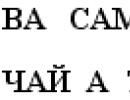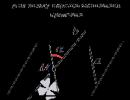Precious fells of kings of 5 letters. Precious fells for solemn cases of the Byzantine emperors, Russian princes and kings
Barma
Barma
(Greek). Widespread defrost, decorated with precious stones, inscriptions and images, which was put on the Moscow kings on the day of their wedding to the kingdom.
Dictionary of foreign words included in the Russian language. - Chudinov A.N., 1910 .
Barma
greek. A wide dealer, which was put on the Moscow kings on the day of their wedding to the kingdom.
Explanation of 25,000 foreign words included in the Russian language, with their roots. - Michelson A.D., 1865 .
Barma
fearing, wear. over clothes at the wedding of Russian kings to Peter V.
Dictionary of foreign words included in the Russian language. - Pavlenkov F., 1907 .
Barma
fools, decorated. precious. Stones, worn by Russian kings (to Peter I -to) with wedding to the kingdom.
A full dictionary of foreign words included in Russian.- Popov M., 1907 .
Synonyms:
Watch what is "Barma" in other dictionaries:
Greek work (drawing of the XIX century) Barma (by different sources, comes from Greek. Parmai round shield, or from Persian. Berme Bechery, protection, or from other Polish. Brama ... Wikipedia
Barma - Tsar Alexei Mikhailovich. 1662 (GMMK) Barma Tsar Alexei Mikhailovich. 1662 (GMMK) Overhead or wide collar, worn over the front dress; Part of the parade princely clothing, to the con. XV century Grandnya, he saw. royal regalia; ... ... Orthodox encyclopedia
Barma, Barm, Ed. No (IST.) Belonging the frontal outfit of the Moscow Princes and Kings, put on the shoulders. "Crown and Barma Monomakh." Pushkin. Explanatory dictionary of Ushakov. D.N. Ushakov. 1935 1940 ... Explanatory Dictionary Ushakov
Precious bellows, decorated with images of a religious nature, by the Byzantine emperors, Russian princes and kings of 14 NCH. 18 centuries. Put on the time of coronation and solemn exits ... Big Encyclopedic Dictionary
Barma, Barm (old.) The genus of the shrouders in the solemn clothes of Russian princes and kings, Byzantine emperors. Explanatory dictionary of Ozhegov. S.I. Ozhegov, N.Yu. Swedov. 1949 1992 ... Explanatory dictionary of Ozhegov
SUT., Number of synonyms: 1 Outlochetic (6) Dictionary of Synonyms ASIS. V.N. Trishin. 2013 ... Synonym dictionary
Under B. usually understand the debris belonging to the decorations of the princely or royal dress. Their better examples are those who were found by the president of the Imperial Academy of Arts by Velenin in 1822, near the village of Old Ryazan. Consist ... Encyclopedic Dictionary F.A. Brockhaus and I.A. Efron
barma - Barm | s (4 *), K with. MN. Barma, part of the jewelry of the main prince's clothing, a mustache with jewels: And Ivan I am in a hooker with a female and a coat of the Vermemi. Andreѣu Slah Moumu Bugai Sobiya with a mustache with the Great Female with a stone. ... ... Dictionary of the Old Russian language (XI-XIV centuries)
Barma - Precious bells, decorated with images of a relig. character. El t options for the wiser. emperors, and afterwards Rus. Princes and kings at 14th. 18 V. During coronation and celebrations. Outputs. Barma. Ryazan, 12 13 centuries ... Russian Humanitarian Encyclopedic Dictionary
Barm; MN. A wide precious teenage with nassed images of a religious nature and precious stones (part of the frontal clothes of Byzantine emperors, and from 14 to the beginning of the 18th century. Russian princes and kings, worn during the solemn ... encyclopedic Dictionary
Books
- Encyclopedic dictionary T-Va BR. A. and I. Granat and K. 7 Edition, a completely recycled edition. Eighth stereotypical edition. Tos fourth. Archeology - Barma. , Yu. S. Gambarov. Reproduced in the original author's spelling (Publisher`thiPography T-Va.Bost benefit``). IN…
- Encyclopedic dictionary T-VA "Br. A. and I. Granat and to °". 7 Edition, completely recycled edition. Eighth stereotypical edition. Tos fourth. Archeology - Barma. , Yu. S. Gambarov. Reproduced in the original author's spelling (publishing house "T-VA" Public Use ") ...
Precious fells for solemn cases of the Byzantine emperors, Russian princes and kings
The first letter "b"
The second letter "A"
Third letter "R"
Last beech letter "s"
The answer to the question "precious devils for solemn cases of the Byzantine emperors, Russian princes and kings", 5 letters:
barma
Alternative Questions in Crosswords for Barma Word
Round wide collar, embroidered by stones, belonging to royal vestments - Ornah
From the XIV century Before the beginning of the XVIII century. - part of the main clothes of the Russian princes (on the likeness of the front door of the Byzantine emperors) - the precious teenage in the form of a round wide collar, fastened from behind a button, which was decorated with small icons
Precious bells, decorated with images of a religious nature, by the Byzantine emperors, Russian princes and kings
Precious fells
Precious fells in the solemn clothes of Moscow princes and kings
Definition of the word Barma in dictionaries
Explanatory dictionary of the Russian language. S.I. IGOV, N.Yu.Shvedova.
The meaning of the word in the dictionary Explanatory dictionary of the Russian language. S.I. IGOV, N.Yu.Shvedova.
Barm (old.). The genus of the shrouders in the solemn clothes of Russian princes and kings, Byzantine emperors. Baro ... The first part of sophisticated words with meanings. pressure (in 2 meanings), for example. Barotherapy, Barosurgery, Barot Ravza.
Encyclopedic Dictionary, 1998
The meaning of the word in the Encyclopedic Dictionary dictionary, 1998
Precious devils, decorated with images of a religious nature, by the Byzantine emperors, Russian princes and kings 14 - Nach. 18 centuries. Dailed during coronation and solemn outputs.
Great Soviet Encyclopedia
The meaning of the word in the Dictionary Big Soviet Encyclopedia
Precious tender, decorated with images of a religious nature. For the first time in Russia, B. appeared at the Moscow Prince Ivan Kalita (14th century). They put on the Byzantine emperors, as well as Russian princes (with the mid-16 century. Until the beginning of the 18th century. Kings) during ...
Wikipedia
The meaning of the word in the Wikipedia dictionary
Barma - a wide tear or a wide collar with nassed images of a religious character and precious stones, put on top of the front dress; Part of the parade princely clothes, and by the end of the XV century - a grand mining, then the royal regalia ....
Examples of the use of the word Barma in the literature.
I, when built, in many parts I visited, and so that the masters were better Barma Yes, a post plan, I did not hear about that.
Motes released, and he went to himself, thinking that it would be nice to work on a new construction assistant Barma And the post room.
A few days later, the king, accompanied by Metropolitan, the near boyars and the architects and Barma Making a trip to the village of Dyakovo to inspect the Temple.
For consolation Barma The post-term counted that, at such a height, the cross of the Temple in clear weather will be visited by a vert for thirty-five.
After such a statement Barma Some promised to come in another time, but did not come.
The attributes of the royal power emphasized the power and wealth of the state of the Russian: the golden decoration of the palace chambers, the abundance of precious stones, the scale of structures, the grandeur of the ceremonies and many objects, without which no Russian king is not thought.
Golden Apple

Golden ball, crowned with a cross or crown, - Power - for the first time was used as a symbol of Russian autocracy in 1557. Having done a long way, the Power came to Russian monarchs from Poland, for the first time by taking part in the wedding ceremony of False Deadmitria I. In Poland, we note, Power was called an apple, being a biblical symbol of knowledge. In the Russian Christian tradition of Power symbolizes the kingdom of heaven. Since the board of Paul I Power was a blue, crowned with a cross, a yachon ball, covered with diamonds.
Shepherdist

The attribute of the Russian government Scepter became in 1584 during the wedding to the kingdom of Fyodor John. So the concept of "Skipteler" appeared. The very word "SKIPETER" - ancient-Greek. It is believed that the tech of the scepter was a shepherd staff, which in the hands of the bishops ended with the symbolism of pastoral power. With the time of time, the Scepter was not only significantly shortened, but also his design was already a little like a modest shepherd staff. In 1667, the Scepter appeared in the right paw of the two-headed eagle - the state coat of arms of Russia.
Throne

The throne, or the throne, is one of the most important symbols of power, first by Prince, then the tsarist. Like the porch of the house, which was created for universal admiration and admiration, with a special trepidation, and to create a throne, and they usually did several of them. One was installed in the Assumption Cathedral of the Moscow Kremlin - this throne participated in the church procedure of the Miropomanization of the autocrat. The other is in the carved chambers of the Kremlin. At this throne, the king sat down after the secular procedure for taking power, he also took ambassadors and influential persons. There were also "mobile" thrones - they traveled with the king and appeared in cases where it was necessary to preferably submit to the royal power as possible.
Tsarsky Venetz

"Golden's hat" is mentioned in all spiritual grants, starting from the moment of the reign of Ivan Kalita. The symbol-crown of the Russian autocracy was supposedly made by the eastern masters at the end of the XIII - early XIV century and donated by the Byzantine emperor Konstantin Monomakh to his grandson Vladimir. Peter I has become the last king, which began Peter I. Some researchers argue that the monomacha hat is not a male, and the female headdress - under the fur neck, allegedly, there were devices for temporal decorations. Yes, it was made of a hat stowed after the death of Vladimir Monomakh. Well, even if the history of this attribute of the royal power is just a legend, it did not prevent him from becoming a sample, according to which all subsequent royal crowns were manufactured.
Byzantine dealers

Custom to carry the dealers, or Barma, came to Russia from Byzantium. There they were part of the frontal robes of emperors. According to legend, Barma sent for Vladimir Monomha, the Byzantine ruler Alexey I Comnin. The chronicle mention of the Barm refers to 1216 - all princes wore all the princes. From the middle of the XVI century, Barma becomes an indispensable attribute of the royal wedding to the kingdom. From a gilded dish in the altar of them at a certain point, Metropolitan bishops was served, which, in turn, received them from Archimandrites. After three-time kissing and worship, Metropolitan laid blessed Barma's blessed by the King, after which the imposition of the crown was followed.
Markets

On both sides of the throne, he could see two inclusive beauties, royal squires and bodyguards - Rind. They were not only a spectacular "attribute" at the ceremonies of receptions of foreign ambassadors, but also accompanied the king during the trips and trips. Rynd's clouds can be envied: Mountain fur coats, saffiana boots, sandy caps ... The place on the right hand was honorable, hence the concept of "locality". The struggle for the honorary title of royal market was the best names of the best names.

The first-known seal of the XII century carved from the metal was the prints of Prince Mstislav Vladimirovich and his son Vsevolod. By the XVIII century, Russian kings used print prints, desktop prints and pendants. The small weight of the latter allowed to wear them on the lace or on the chain at the belt. The prints were cut on metal or stone. A little later, a mountain crystal and its varieties becomes a favorite material. Interestingly, from the XVII century began to print with a removable legend - the text, which allowed the new king to use the seal of his predecessor. At the end of the 18th century, the Russian kings had more than two dozen different seals, and the seal of the European engraver Johanna Genndlinger with a powerful double-headed eagle served by Russian monarchs over the century, until the end of the board of Nicholas I.
Tell me from what was the front robe of the Russian kings? (+) and received the best answer
The answer from the user is removed [Guru]
From the 10th century, in Russia, it went to the custom of richly to decorate the clothes and parts of the body by genuine stones, and sometimes the outfit became so hard that it was not possible to wear it - so it was interrupted the wedding of Tsar Alexei Mikhailovich, because the future spouse did not stand the weight precious dress.
During big holidays and celebrations, what were the Christmas of Christ, the Epiphany, the week of verbal, the bright resurrection, the Troitin day. Assumption and Some Others, the sovereign in the Outfit Tsarsky, to which belonged to: a royal dress, actually Porphira, with wide sleeves, the royal edge of the caftan, the royal hat or crown, a diadem or a barma (rich fell), a mere cross and a digestion assigned to the chest ; Instead of the staff, the royal silver rod.
All this shone gold, silver and expensive stones. The most shoes who put on the sovereign at this time were also richly lured by pearls and decorated with stones. The severity of this outfit was no doubt very significant, and therefore, in such ceremonies, the sovereign was always maintained under the hands of so many worms, and sometimes a boyars from the neighboring people.
http://supercook.ru/zz320-tsar00.html
Alexey Mikhailovich was especially in all its royal magnificence into large holidays of the Orthodox Church, which glorified at that time a pomp and the uniqueness of rites corresponding to each holiday; They delivered the king with the opportunity to show their outdoor union and the monarch of greatness to different freedoms. In the Christmas evening, the Tsarist Terem was announced by the singing of Slavchelikov, who had some others from different churches and the abode; In the baptism of the king in his diadima (shoe lace) and the royal dress, the humiliated pearls and mowed expensive stones, was marched to Jordan, accompanied by all the officials of people, dressed according to their rank, as it can be elegant (poorly dressed was distilled away)
The wealth of royal clothes was dazzling, especially when our state trucks were in solemn days to exit or crowned. Tsar Feodor, according to eyewitnesses, exceeded the magnificence of all preceding coronations. One scepter shrouded with precious stones was 3.5 feet long and cost several million; Tissue of the king weighed at least 200 pounds; Six princes held the tail of the mantle; Velmazheby was shining with diamonds, yachons and pearls of amazing magnitude, valued by millions. On the outfit of Tsar Mikhail, the former during his marriage, it was said that he was in the casing of the Gold Auxamit, on Soboli, and in the fur coat, the Russian Sable, covered with a velvet zero, clutch the floors by the shoulder.
hT TP: // [link will appear after checking by moderator]
From 1547 - the first wedding to the kingdom of Ivan the Terrible and until 1682 - the wedding of the king of the kings of Ivan and Peter Alekseevich, the Momomakh hat was used in the delivery of all Russian sovereigns. She became the most revered attribute of the royal power and the personification of the responsibility of the king before the subject. On this, the words of Boris Godunova, hints A.S. Pushkin: "Oh, herself, you, a monomacha hat." In the solemn ceremonies of the XVIII-XIX centuries. The monomacha hat was carried out as "the main memorability of the royal dignity in the coronation and burials of the imperial" Tula caps consist of 8 gold conic plates, ending with a four-penette cross hemisphere. On the lateral edges of the plates, the pattern forms borders, resembling grooves with twisted ribbons. Amazingly beautiful, transparent, like lace, Patterns are attacked on a smooth golden field - this is a scan. Gemstones complement the decorations. Initially, the bottom of the caps had pearl suspensions, and then a flop of a sable. Height caps - 698 gr. Indeed, the monoma hat is not easy, but there are royal caps and harder, for example: the crown of Tsar Mikhail Fedorovich weighs 5 pounds \u003d 2 kg. 48g, Kazanskaya hat - 4 pounds 80.
Source: According to the existing position, the monomach cap was dressed once in his life - during the wedding to the kingdom. For other solemn moments, each king had its own elegant hat - the crown. The crowns could be somewhat and, depending on the importance of the event, the king put on the other hand.
Answer from Victoria Makhrakova[guru]
All the kings to Peter 1 were crowned into the Russian throne of the famous monomacha hat. The weight of the hat 698 grams - the crown is very light, although Pushkin wrote about him: "You are heavy, the monomacha hat." King Mikhail Fedorovich "Astrakhan's hat" - twice as harder. The first mentions in the wedding documents with the monomach cap refer to 1498. The last time this cap was crowned in 1682, when two kings came to the Russian throne at once - Ivan and Peter.
In 1665, we are talking about Alexei Mikhailovic (1629-1676) - Russian King (from 1645), the second representative of the Romanov dynasty on the Russian throne, the son and successor of the king Mikhail Fedorovich Romanova.
In 1665, Lekari was advised by the treatment of tea with the king Alexey Mikhailovich, who "laughed in his stomach pain." Perhaps with this fainting.






